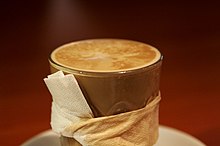Milk coffee
Milk coffee is coffee with a high proportion of milk or milk foam that is mainly drunk in the morning in various countries. In the Netherlands it is also known as koffie verkeerd ("coffee wrong"). In Vienna , a coffee is a small mocha with frothed milk. In Switzerland, milk coffee is called a bowl after the drinking vessel .
France
The French term café au lait [ kaˈfe oˈlɛ ] ( French for coffee with milk) means coffee with usually hot milk, with the drink consisting of half coffee and half milk. In Paris it is also called café crème , although sometimes, as is traditional (especially elsewhere in France), this can mean a coffee with cream. In France, a baguette or croissant is often dipped into the white coffee.
Netherlands and Belgium
The koffie verkeerd ( "coffee wrong"), like the café au lait from coffee and hot but not boiling whole milk; the milk content is higher, however, 2/3 hot milk and only 1/3 coffee is desired. In the francophone part of Belgium, the name of the koffie verkeerd lait russe . Prepared in glasses, a well-prepared koffie verkeerd shows milk and coffee in separate layers.
Italy
In Italy a caffellatte (also caffè latte or caffè e latte ) is the local variant of the milk coffee. This latte, often drunk for breakfast, can be served in a large glass or bowl. It consists of a single or double espresso with hot milk. Milk foam is only rarely used.
The (or the) latte macchiato (“speckled milk”) could also be seen as a variant of the milk coffee, but with big differences: the typical café au lait contains roughly equal amounts of coffee and milk. “Latte”, as is often briefly said in German, consists of espresso, (a lot) of hot milk and milk foam, occasionally in a glass and then poured in layers.
- More details on coffee / espresso with milk in Italy at Espresso (with different ingredients) .
Austria
In Austria , the normal milk coffee is called Melange ; the Viennese melange is served with frothed milk. There is also the large brown and the small brown as a name for mocha with cream (cream). If you order a caffè latte in Austria, it is usually served similar to a latte macchiato.
Spain
Cortado is a Spanish coffee specialty and consists of espresso that is "blended" with slightly hot, frothed milk (Cortado natural) . One variant is the Cortado condensada or Café bombón . In this case, sweetened condensed milk is added to the espresso . The Cortado leche leche ("milk and milk") is drunk on the Canary Islands , especially on La Palma . In this case, both heated fresh milk and sweetened condensed milk are added to the espresso.
The barraquito is a variant of the Cortado leche leche with alcohol. It is a specialty in the western Canary Islands. In layers, the barraquito contains condensed milk, Licor 43 , espresso and frothed milk from bottom to top . On top there is usually a piece of lemon and some ground cinnamon .
In Catalonia and the Balearic Islands , the Cortado is also called tallat ( Catalan for “cut”). In Cuba it is called cortadito .
Café con leche is the Spanish form of milk coffee. As usual in Spain, it consists of an espresso with milk. The roast of the coffee beans is usually darker than in Germany. About twice as much coffee as a cortado is served in a cup. The milk heated or frothed with the steam from the espresso machine is often placed separately in a small jug on the table. The usual mix is one on one.
Portugal
In Portugal , especially in the north near Porto , you know the cortado also called pingo ( port. Drop) or pingado in Lisbon he called Garoto (Portuguese for boy or boy).
Galão is a mixture of espresso and hot milk in Portugal. Like Italian latte macchiato, a galão is usually served in a glass.
Meia de leite is a Portuguese milk coffee in a cup that is mixed from an espresso lungo and milk in a ratio of 1: 1.
Café com leite is coffee with milk and was also the name of a political alliance in the history of Brazil .
Web links
Individual evidence
- ^ Christoph Wagner : Coffee is wrong . In: Ders .: The lexicon of Viennese cuisine . Vienna 1996.
- ^ Teresa A. Meade: A Brief History of Brazil . Ed .: Infobase Publishing. 2010, ISBN 978-0-8160-7788-5 , pp. 123 ( limited preview in Google Book search).




